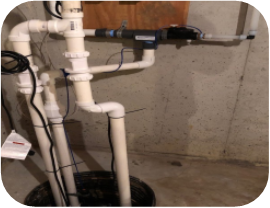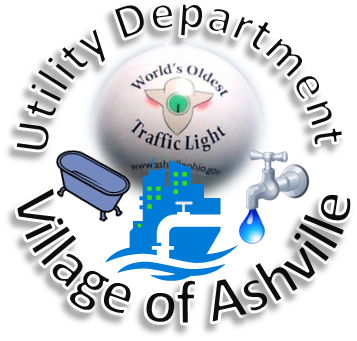
This webpage is designed to explain plumbing leaks, how they can have a significant impact on bills, how you can identify a leak, and our utility billing fee structure. Please click on the links from the "Article Index" for the topic you wish to read.
| Drip, Drip, Drip | 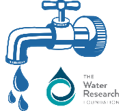 |
Leaks from pipes, plumbing fixtures and fittings are a significant source of water waste for some households. A “2016 Residential End Uses of Water Study” (https://www.waterrf.org/) found that the average household loses about 17 gallons of water per day to indoor leaks. Some leaks are obvious, such as dripping faucets and leaking water heaters. Unfortunately, many leaks go undetected for years because the source of the leak is not visible. The following information outlines the many sources of leaks and how high utility bills can be generated.
Common Causes of a Leaky Pipe (Equipment)
|
Tubs and Toilets Tubs and showers have seals designed to keep water moving down drains and to the sewer. Sometimes, a seal is faulty. For a homeowner, this can create a disaster, especially if the leak isn’t noticed for a long time. Toilets also have seals that ensure water drains to the appropriate place. Leaks in bathrooms go undetected because they’re typically in places where you can’t see the evidence immediately. Water may have been soaking into subflooring for months, where it creates the perfect environment for mold growth. The first sign of a tub or toilet leak may be stains on the ceiling or joists in the area below the bathroom. A toilet leak is a common problem that can often be overlooked but be the cause of your higher water bill. Sure, you can jiggle the handle but that’s only a temporary fix. Some causes of a running toilet could mean a faulty stop valve or floater switch. To fix it, carefully remove the lid and place it in a safe spot. You will see a large bulb inside and that is the part that must be replaced in order to fix it permanently. |
  |
No homeowner wants to deal with a water leak. Some people ignore water leak symptoms because they’re afraid of what they might find if they go poking around behind walls and near pipes. Learn the five most common causes of water leaks in your home so you’re prepared to deal with them.
|
Clogs Clogs are often seen as nothing more than an annoyance. While this may be true, they can also be the cause of a leaky pipe. When a clog goes untreated, pressure can build up behind it. This pressure can be too much for a pipe, causing it to crack or break. Some types of clogs can also have corrosive substances in them, such as a cleaner, which can expedite damage to the pipe and eat through the metal. If you develop a clog in any pipe in your home, it’s essential to address it as soon as possible. |
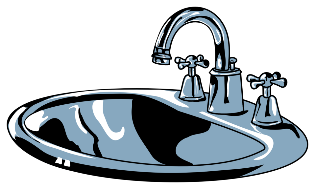 |
 |
| Hot Water Heaters
Water heaters generally have an 8- to 12-year lifetime before they give up on providing you with that nice hot shower. Sometimes, you know when a water heater is wearing out, and you can be proactive about either repairing or replacing it. It’s not unusual, however, to be blissfully unaware of a problem until you realize you have a small creek in your basement. Time to call a plumber! |
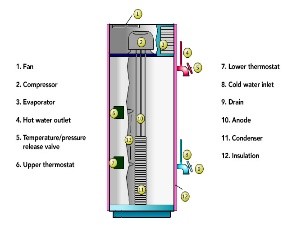 |
| Water Softener Leaking
Water Softener Leaking from The Top Common Culprit #1: Rotor Valve If your water softener is leaking from the top, there are a few common culprits. One of these is the rotor valve. This valve is the source of water for the softener. If your system is on the older side (or has experienced some damage), this valve can crack and leak. This valve also contains a seal. If you don’t notice any cracks on the valve itself, the seals inside may be damaged and to blame for the leak. In either scenario, you’ll need to contact a professional with access to replacement parts for your softener. Common Culprit #2: O-Rings in Bypass Valve Another potential cause of a water softener leaking from the top is defective bypass valve o-rings. As part of water softener maintenance, you occasionally need to have a professional lubricate these o-rings to keep them functional. As the system reaches the 20-year mark (which is how long softeners typically last) you may need to replace the o-rings altogether. |
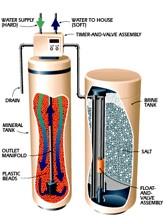 |
While most aspects of softener maintenance are DIY-friendly, you’ll need someone with access to the right parts and know-how to solve a bypass valve o-ring issue promptly.
|
Water Softener Leaking from The Bottom Common Culprit: A Punctured Brine Tank If your water softener is leaking from the bottom, it is almost certainly a brine tank issue. The brine tank is where you place salt. A water softener that’s leaking at the base is usually caused by an overly aggressive attempt to clear a salt bridge. At American Home Water and Air, we’ve seen plenty of people puncture their brine tank by poking at a salt bridge too aggressively. Unfortunately, if your water softener brine tank is leaking, your best bet is going to be replacing the tank altogether. Certain types of epoxy may help contain the leak for a short time but you risk further damage and malfunctioning of the unit.If you’re certain you didn’t cause damage to the tank yourself, contact the company that installed it for you. The issue may be covered under warranty. |
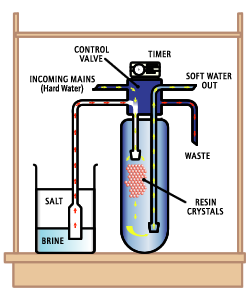 |
Water Softener Leaking from The Drain Line
You can usually find a water softener drain line running near the top of the unit or even further up. If your water softener is leaking from the drain line, this will be hard to miss or misdiagnose.
To solve this issue, call a water softener repair expert. They should be able to solve the issue by replacing the faulty plumbing.
Water Softener Hose Leaking
If your water softener hose is leaking, you’ll be able to tell by looking at its connection to the top of the unit. If it’s come loose for some reason, solving the issue could be as simple as tightening the connection. As with all components, however, a water softener hose can wear down over time. If the hose itself (as opposed to its connection to the softener) is leaking, you will need to have it repaired or replaced by a professional.
Thankfully, this is a fairly simple operation. If you’re handy around the house, you may be able to do it yourself — after you’ve disconnected the unit’s electricity and water supplies.
|
Water Powered Sump Pump A water powered sump pump uses 1 gallon of your village’s water to pump out either 1 or 2 gallons of water from your sump pump basin. Using the ratio of 1 to 2 at 1,000 Gallons Per Hour (GPH), this system will use 5,000 gallons of water to prevent 10.000 gallons from flooding the basement. Another fact is that a water powered sump pump requires a minimum of 20 PSI to operate. Since it does use water, and if it runs a unabated have you consider the cost to operate? Some water powered sump pumps are not maintenance-free. Their instruction manual states a filter needing to be installed in the water supply line to remove particles before they reach the pump. These pumps need to be manually activated once a month to prevent calcium deposits and debris from building up in the unit, or the pump may fail. The water powered sump pumps operate quietly which is a nice feature. Except when the ON/OFF switch breaks, because it can break in the ON position, which means the pump will run continuously using your home water supply. |
|
Some electric sump pump with a battery backup, can run up to 166 hours depending on how often it cycles (and you can also add additional batteries if needed to make it last even longer).
|
James Welsh, Water Operator, worked with a resident that noticed a doubling of their water bill. Mr. Welsh discovered the water powered sump pump was coming on every few minutes. While this may be better than water in the basement, it can be a very expensive alternative to electricity. A thousand gallons of water will cost $19.81. The estimated usage for a water powered sump pump is 180 gallons per hour or 4,320 per day or 129,600 per month. It is not likely that it would operate continuously but you can see by the numbers it could become expense. $86 for 24 hours that could be spread over a number of days. You may hear a water powered sump pump is a “Green” alternative or will cost less for the equipment set-up. This article is not to tell you what to do but to inform you about the possible results of not monitoring your sump pump. Some municipalities will not approve a water powered sump pump because of the wasted drinking water. There is also a concern about a water line being connected to a sump pump discharge line carrying “greywater”, in case there is a backup from the sump pump.
|
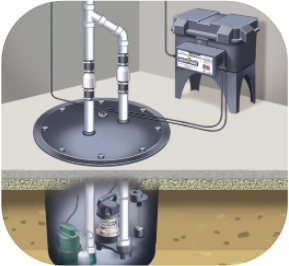 |
Pros and Cons Water and Battery Sump Pumps
https://insights.globalspec.com/article/12877/pros-and-cons-of-battery-and-water-powered-backup-sump-pumps
|
Other Sources of Leaks
Outside Faucet |
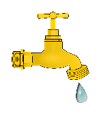 |
| Swimming Pool |  |
| Hot Tub |  |
| Irrigation System |  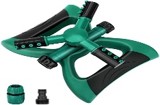 |
| Ice Maker |  |
| Dish Washer | 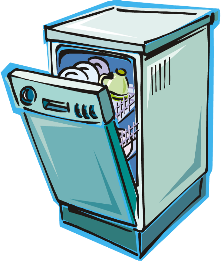 |
| Clothing Washier | 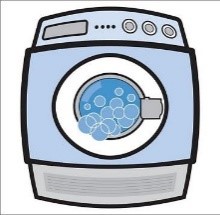 |
| Clothing Dyer (those that have steam capacity) |  |
Common Causes
of a Leaky Pipe
(Infrastructure of Location)
|
Corroded Pipes Corrosion in your pipes is an inevitable issue. You could insulate the metal to maintain its durability, but still, corroded pipes will happen eventually. When your pipes become corroded, pinholes can begin to form, resulting in small leaks in your pipes. Over time, pipes can develop corrosion, such as rust. Corrosion is a chemical reaction between the metal and the substances in the environment. In the case of your pipes, it is what is found in your water that can cause the corrosion to occur. Corrosion eats away at your metal pipes, causing them to weaken. Corrosion can also eventually create holes, which then allow water to escape. If you have pipes that were laid several years ago, they might be at a higher risk of corrosion than newer pipes. Corrosion can also happen because the pH of the water or the water’s mineral content is off. To check what your water’s pH levels are, purchase pH test strips at any hardware store. The recommended pH level for your water is 6.5 to 8.5. If you have high or low pH water, install water treatment tools to balance out the pH levels. |
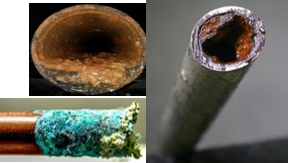 |
| Damaged Joints
The joints are typically the weakest areas of your pipes. They are the curved parts of the pipes that cause the water to change direction so that it can get to where it needs to go. In some cases, the joints can weaken over time, which can then allow a leak to form. The first sign that there’s an issue with the joints is strange noises when the water, more specifically the hot water, is running. You might hear a clacking or banging sound in the pipes. |
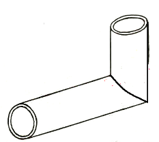 |
|
The Pipes are Laid Improperly Many leaks develop because the pipes were laid incorrectly. When it comes to laying pipes, the job should be done by a licensed professional. Pipes and connectors have to be laid correctly. Backflow devices should be used as necessary. If your pipes haven’t been installed correctly, you could be left with a serious plumbing problem as well as a lot of water damage to your home. The next thing you know, you’re paying to have the pipes fixed, and you’re paying other expensive repair bills. If you are unsure of whether or not your pipes were laid correctly, a professional plumber can evaluate them for you. |
 |
|
Cracks in a Fixture Sometimes cracks in your fixtures happen. Someone might have tripped and caught the fixture in the process. A ball may have been thrown in your home that hit the sink faucet. Or, perhaps you shove something repeatedly underneath the sink without realizing that you’re hitting the pipe. Cracks in faucets are generally noticeable immediately. You’ll see the crack from where the water leaks through. For cracked fixtures under the sink, you might not notice it right away until you find that the area underneath is damp. The Pipes Have Shifted |
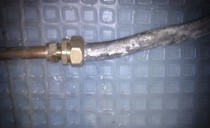 |
| Old Pipes
Pipes can last a while, but they’re not meant to last forever. Older pipes are made from materials that are much more prone to corrosion, such as iron. When corrosion occurs, the pipe weakens and begins to break down. This can eventually result in a leak. If you have older pipes, it may be recommended to upgrade to newer ones. Newer pipes are generally made from copper or plastic, which is resistant to corrosion. While copper pipes won’t last forever either, at least you won’t have to worry about corrosion being the problem that damages them. |
 |
|
Tree Root Intrusion Leaks can begin outside of the home just as quickly as they can begin inside. One of the most common causes of a leak that starts outdoors is an intruding tree root. While the root of the tree in your yard might not have been an issue when the pipes were first laid, they may gradually make their way over as the tree continues to grow. If the root intrudes and damages the pipe, the water can then leak out into the dirt. A dip in water pressure is a common indicator of a leak. If you notice this dip along with a wet patch in your yard (and there’s a tree nearby), it could very well mean that the root of the tree has damaged the pipe. Tree roots also can be the culprit when water leaks into a basement. These roots can exert pressure on water pipes, which causes them to crack. If you do find that your leaky basement is caused by tree root invasion, don’t ignore it. You might turn an already expensive repair into a major financial disaster. |
 |
|
Broken or Damaged Seals Seals appear in a few different places around your plumbing. Anywhere your pipes connect to faucets or other fixtures, rubber seals should have been placed around them. These seals are meant to keep the connection watertight. The problem, however, is that rubber seals aren’t made to last forever. Over time, they can wear out. They can get damaged and break. When the seals are damaged or broken, this breaks the watertight seal. As a result, water can get out. Water or condensation near a fixture could be indicative that there’s a loose, damaged, or broken seal. |
 |
|
Shifting happens. There could be an issue with your foundation or settling may have occurred. There may have been erosion, a flood, or tremors from an earthquake. When your home shifts, the pipes shift too. When this happens, the connections can break. Changes in your plumbing can indicate shifting, particularly after a flood or major storm. You might notice the water pressure has changed or that the watercolor has changed. These issues can mean that there’s a leak in your pipes that should be addressed right away. While Ashville may not have many earthquakes, if compaction of soil is incomplete after a work project the ground can and has shifted in locations. |
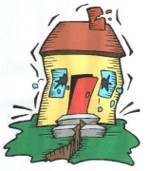 |
|
Temperature Fluctuations Temperature fluctuations can cause your pipes to expand or contract. When these fluctuations occur rapidly, expansion and contraction can damage the pipes. This is a particularly common issue in the freezing temperatures of winter. If the damage leads to the formation of a crack, then a leak can develop. This can be an issue with older pipes as well as newer ones. Any pipes made from metal are susceptible. Now that you know a bit more about what a few common causes of water leaks are, you’re better prepared to prevent them. Check periodically for signs of water damage. Pay attention to clogs and deal with them quickly. Have your water heater inspected each year. Prevention may save a homeowner from inconvenience and financial hardship. Keep your plumbing system and your wallet free of leaks. |
 |
Ways to Tell if Your House Has a Plumbing Problem Present
If you’ve ever encountered a plumbing issue in your home, you know that there is worse than having a leak on your hands — especially when you can’t detect the initial source at first glance. Here are a few signs to be on the lookout for that proclaim you should call a plumber immediately.
Water Damage
If you happen to see water marks or bubbles on a nearby ceiling or wall, that can indicate that you have a plumbing problem on your hands. While this is often due to a leaking pipe, sometimes a roof that needs to be repaired may cause those seemingly random water spots on the ceiling.
Continuously Running Water Meter
A water meter that continuously runs is not a good thing — especially if you know that no one in your home is using water. To indicate whether or not you have a hidden plumbing leak present, walk around your home and make sure that anything that uses H2O is shut off. Once complete, go to your water meter and recheck it. If it’s still running, you have a leak present.
Higher Water (H2O) Bills
Have you noticed an increase in your home’s water bills out of nowhere? If so, that can indicate that there’s a plumbing problem somewhere in your house or outside of it. The EPA states that 90 gallons of water are wasted, per day, by ten percent of households with a leak present.
The minute you feel that there may be a lingering leak, call your plumber right away to get to the root of the problem and stop it in its tracks.
High Water Pressure
Who doesn’t love a strong hot shower in the morning? It’s a great way to wake up and face the day. It’s also a sign that you may have water pressure that’s too high. Why should you care? The water pipes in your home are not designed to withstand high water pressure for an extended amount of time. Normal water pressure should be 60 pounds per square inch (psi). Pressure higher than 80 psi can cause pipes to develop multiple pin holes, which leads to a large-scale water mess in your home. If you’re not a handyman and don’t have the necessary tools to check water pressure, call a plumber. You can combine the visit with your yearly hot water heater check and main sewer line inspection.
Once you know you have a leak how can you tell where a water leak is coming from?
Sometimes leaks can happen right under your nose. Before you start ripping out walls, the easiest way to check whether you have a water leak is by reading your water meter. Some water meters are found in the basement, right above your main water shut-off valve. The leak indicator (small colored symbol beside the meter hand) will be moving if there’s a water leak in your home. Next go to your toilet and turn off the water at the valve. Go back to the water meter and see if the leak indicator has stopped. If it has you have located the source of the leak. Go to each valve in your home and shut off a valve. Once the meter has stopped indicating a leak, you have located the source. Now go back one by one and turn on the valves you have tuned off. Check the water meter before you go to the next valve. This will allow you to determine if you have more than one source for a leak. If after tuning off all valves the leak is still being indicated, it is now time to contact a plumber. Some locations may not have shut off valve, i.e. tub, outside faucet.
|
Leaking pipes are a major issue. They can cause severe damage to your home, ruining ceilings, floors, walls, carpets, furniture, and more. The moisture can encourage the growth of mold and mildew. All of these problems can then result in some rather expensive repair bills. Not only that, but leaky pipes also waste water, which means you’re paying a whole lot more on your water bill for the water you’re not even using. One of the most significant issues with leaks is that you can’t see the pipes in your home, so you might not even know that one has developed. Understanding the most common causes, however, can enable you to contact a plumber and prevent future issues. |
 |
Itemized Fee Structure
Since this Newsletter discussed what may cause an increase in your utility bill, it would be a good opportunity to discuss what is on the utility bill. It is made of the following seven charges:
- Water Unit Cost is $3.74/1,000 Gallons
- Sewer Unit Cost is $7.61/1,000 Gallons
- I & I is 34¢/1,000 Gallons *
- Tank Fee is 26¢/1,000 Gallons **
- Debt Service is $7.86/1,000 Gallons ***
- Stormwater is $3.00/ERU ****
- Refuse/Recycle is $16.72 /month Senior Citizen $15.09t *****
As you can see this bill has two charges that are the same each month-stormwater and refuse/recycle. The other four charges are multiplied per 1000 gallons each month. The water and sewer charges is adjusted each year for the prior year Consumer Price Index (CPI), Reference Ordinance 2009-03. We do not have that information for 2020. That adjustment is usually published in the March Newsletter indicating the percentage and new rate, generally between 0.3 and 1.5%.
* I & I Infiltration & Inflow correction as mandated by the Ohio EPA Director’s Final Findings & Orders
** The Tank Fee is the cost to refurbish and maintain the water towers at the Water Plant & State Route 752, Reference Ordinance 2011-01
*** Debt Service Cost to acquire land, design, and construct a Water Resource Recovery Facility as mandated by the Ohio EPA Director’s Final Findings and Orders, Reference 07-14 Resolution and Ordinance 2016-07
**** Equivalent Residential Unit for Residential Average 2,000 Sq. Ft. of Impervious Area, Reference Ordinance 2006-14, Chapter 929.08
***** Refuse residential cost from Service Agreement with Local Waste Services, Ordinance 2017-10
Link to Codified Ordinance on Village of Ashville Utility
Final Thoughts
No one wants to deal with a leaky pipe. Dealing with it as soon as you notice it, however, will help to save your property and your wallet. If you see any signs of a leak, such as a dripping faucet, an increase in your water bill, or a musty smell, it is vital to call a plumber to get the issue taken care of as soon as possible.

